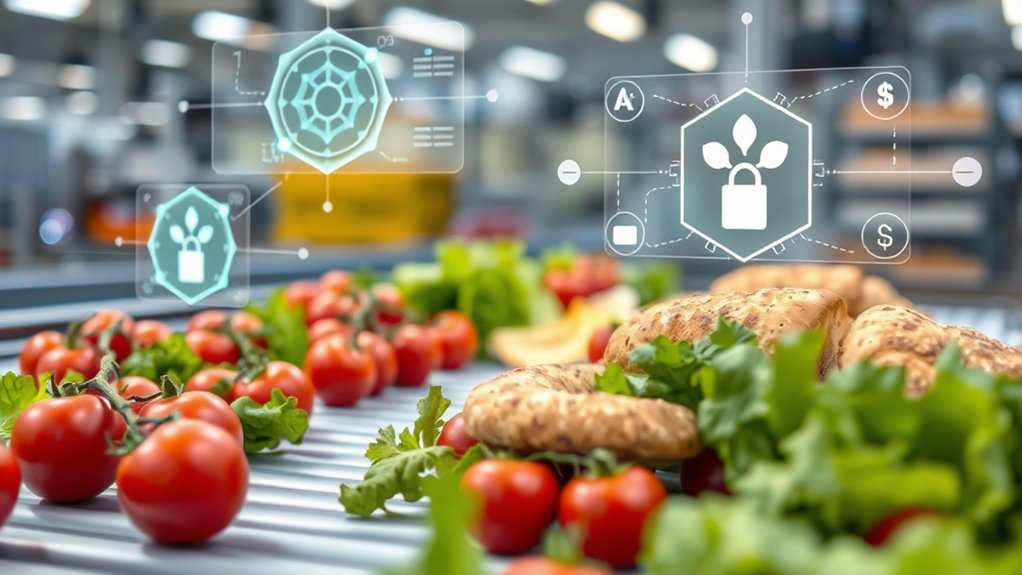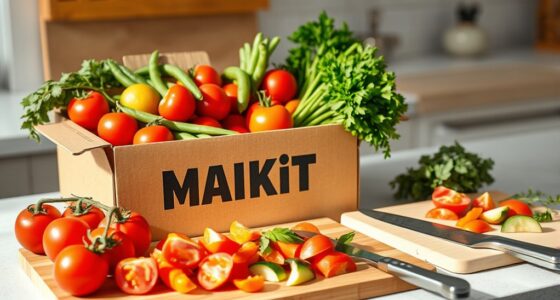Using blockchain for food safety and traceability puts you in control of a transparent, tamper-proof system that tracks every step of your supply chain in real time. It makes identifying contamination sources faster, reducing investigation times and preventing widespread outbreaks. With shared, verified data, you can improve transparency, build consumer trust, and comply efficiently with safety standards. Interested in how this innovative approach can transform food safety practices? Keep exploring to discover more.
Key Takeaways
- Blockchain creates an immutable, transparent ledger that enhances food traceability and verifies the safety and origin of products.
- It enables real-time tracking of supply chain movements, facilitating quick identification and response to contamination sources.
- Shared blockchain platforms promote collaboration among stakeholders, reducing fraud and ensuring consistent safety practices.
- Replacing traditional records, blockchain streamlines compliance, accelerates recalls, and improves decision-making processes.
- Integrating blockchain increases transparency, builds consumer trust, and strengthens overall food safety management systems.

Blockchain technology is transforming how we guarantee food safety and traceability. With its decentralized and immutable ledger, you can now track every step of the supply chain with unprecedented accuracy. This level of transparency ensures that every participant — from farmers to retailers — records data in a way that’s accessible and verifiable. As a result, supply chain transparency becomes more than just an ideal; it turns into a practical tool that helps you quickly identify where issues originate and prevent potential crises before they escalate. When contamination occurs, blockchain allows you to trace the exact source of the problem, making contamination detection faster and more reliable than traditional methods.
Blockchain ensures transparent, accurate supply chain tracking for faster contamination detection and improved food safety.
In the past, tracing contaminated food often involved lengthy investigations, multiple parties, and incomplete records. Now, with blockchain, you have a single, tamper-proof record of every transaction and movement of goods. When a food safety concern arises, you can pinpoint the contamination point instantly, reducing risk to consumers and limiting financial losses. This real-time traceability also builds consumer confidence because they can verify the origin and safety of their food through transparent records accessible via blockchain networks. You’re empowered to respond swiftly, minimizing the spread of contaminated products and maintaining public trust.
Moreover, blockchain enhances collaboration across the supply chain by providing a shared platform where all stakeholders can upload and verify data. This shared transparency discourages malicious intent or fraud and ensures that information about food safety practices, handling, and storage conditions is accurate and consistent. As a result, you can identify potential vulnerabilities early, implement corrective actions, and maintain high safety standards. This collaborative approach not only improves contamination detection but also fosters accountability at every level of the supply chain.
Another advantage of blockchain in food safety is that it reduces reliance on paper records or siloed systems, which are often prone to errors or manipulation. Instead, you get a unified, tamper-proof ledger that’s accessible in real-time, enabling quicker decision-making. Whether you’re a producer, distributor, or retailer, this technology streamlines compliance with safety regulations and helps you meet stringent standards without hassle. It also facilitates recalls—if contaminated products are found, blockchain allows you to remove affected products rapidly, avoiding widespread outbreaks.
In essence, blockchain is revolutionizing how you manage food safety and traceability. By increasing supply chain transparency and enhancing contamination detection, it empowers you to ensure safer food, respond swiftly to crises, and build trust with consumers. This innovative technology is not just a trend; it’s an essential tool that improves every aspect of the food safety journey, creating a more secure, transparent, and accountable system for all involved. Additionally, integrating digital record-keeping with traditional methods can further strengthen traceability efforts and reduce errors.
Frequently Asked Questions
How Does Blockchain Improve Food Recall Efficiency?
You can improve food recall efficiency by using blockchain, which provides real-time tracking of products from farm to table. Smart contracts automatically trigger alerts when issues are detected, speeding up recall processes. This transparency and instant data access allow you to quickly identify affected batches, notify stakeholders, and remove contaminated items, minimizing health risks and reducing financial losses. Blockchain’s secure, immutable records make recalls faster and more precise.
What Are the Costs of Implementing Blockchain in Supply Chains?
Implementing blockchain in supply chains involves costs related to a thorough cost analysis and infrastructure requirements. You’ll need to invest in new hardware, software, and secure networks, which can be expensive upfront. Additionally, training staff and maintaining the system adds ongoing expenses. While these costs might seem high initially, they often lead to improved transparency, efficiency, and reduced fraud, making the investment worthwhile in the long run.
How Does Blockchain Handle Data Privacy Concerns?
Did you know 84% of consumers worry about their data privacy? Blockchain handles data privacy by using data encryption, ensuring your information is secure from unauthorized access. It also employs access control, allowing only authorized parties to view or modify data. This combination keeps your data safe, transparent, and tamper-proof, addressing privacy concerns effectively while maintaining the integrity of supply chain information.
Can Small Farmers Adopt Blockchain Technology Easily?
Yes, small farmers can adopt blockchain technology, but it depends on their access to technology and education. You might need to invest in farmer education programs that simplify blockchain concepts and show how it benefits your farm. Improving technology accessibility is essential, so look for local initiatives or partnerships that provide affordable tools and support. With proper guidance and resources, blockchain can help you enhance traceability and market trust.
What Are the Limitations of Blockchain for Food Safety?
You might face limitations with blockchain for food safety, such as regulatory hurdles that slow adoption and create compliance challenges. Additionally, the technology’s complexity can be overwhelming, especially for smaller producers lacking technical expertise or resources. These factors can hinder seamless implementation, making it harder to fully leverage blockchain’s potential for ensuring food safety and traceability. Overcoming these barriers requires coordinated efforts among stakeholders and supportive policies.
Conclusion
Just as the phoenix rises from ashes, blockchain technology renews your trust in food safety and traceability. By embracing this innovation, you’re not only safeguarding your health but also shaping a transparent future where accountability and integrity shine through. Remember, in the quest for quality, it’s your vigilance and commitment that truly forge a safer, more trustworthy food supply—because in the end, the future of food safety depends on the choices you make today.








